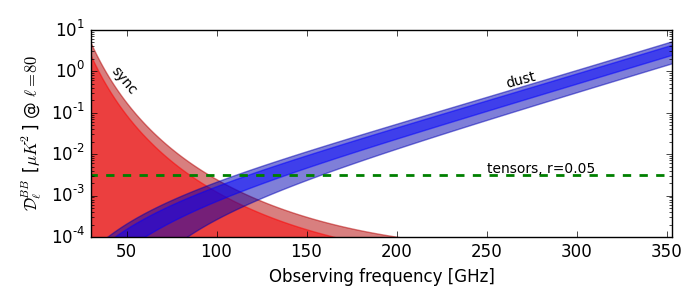Our attempts to measure the Cosmic Microwave Background are more difficult because we live in a galaxy, surrounded by very diffuse matter that emits microwaves. While our observations target the “Southern hole”, a very clean region of the sky, foregrounds are still significant in comparison to the faint B modes we are trying to detect.
For polarization measurements, we focus on two classes of Galactic foreground:
- Synchrotron radiation is emitted by relativistic electrons that travel on spiraling paths in our Galaxy’s magnetic field. The energy spectrum of the electrons leads to a synchrotron spectrum that is brighter at low frequencies and faint at higher frequencies.
- Dust is a general name for microscopic bits of matter in interstellar space. Starlight heats up the dust, causing it to glow in microwaves. The typical temperature of dust is ~20 Kelvin, so its blackbody emission peaks at higher frequencies than the CMB.

The above figure shows our best estimate of B-mode foreground amplitudes in the Southern hole, derived from a joint analysis of BICEP2, Keck Array (2012+2013), and Planck. The red region shows one and two sigma upper limits on synchrotron power (which we haven’t actually detected in our field) while the blue region shows the one and two sigma estimates for dust. The dashed green line shows the contribution to the BB spectrum for gravitational waves from inflation with tensor-to-scalar ratio r=0.05. For all three signals, the power levels shown are for angular scale of ~2 degrees (ℓ=80). For this particular choice of tensor power, the target CMB signal barely exceeds the foregrounds near the 100 GHz minimum.
A large part of my current research is focused on separating the synchrotron, dust, and CMB components of our data from BICEP2 and the Keck Array. The primary handle we have on this problem are observations at multiple frequencies. By observing the same region of sky at multiple frequencies, we can disentagle synchrotron (brighter at low frequency), dust (brighter at high frequency), and CMB (uniform brightness at all frequencies). While the observations from BICEP2 and the first two years of Keck Array were all at 150 GHz, we have taken advantage of Keck Array’s modular design to extend our frequency coverage to 95 GHz (Keck 2014+2015, BICEP3 2015) and 220 GHz (Keck 2015). Also, our analysis makes use of full-sky polarization maps from the Planck satellite. While the level of Planck noise in the Southern hole is much higher than the noise in BICEP2/Keck maps, Planck has released polarization observations in seven frequency bands ranging from 30 to 353 GHz. Their low and high frequency maps play a critical role in constraining foreground models.
While some might find the new emphasis on foreground separation and cleaning to be a disappointment, compared to the early excitement surrounding the initial BICEP2 publication, I think that it shows we have entered a new era of CMB polarization. For a dozen years since the initial detection of E modes, a variety of experiments published steadily improving upper limits on B modes. Thanks to the exceptional sensitivity of BICEP2 and Keck Array, we have now entered an era of high significance B-mode detections, which leads to new challenges as we attempt to characterize the measured signals.
Additional Information
- BICEP2/Keck, and Planck Collaborations (2015), A Joint Analysis of BICEP2/Keck and Planck Data, Phys. Rev. Lett. 114, 10, 101301 [ADS, arXiv:1502.00612]
- Planck Collaboration, Planck intermediate results. XXX. The angular power spectrum of polarized dust emission at intermediate and high Galactic latitudes, accepted in A&A [ADS, arXiv:1409.5738]
- Dunkley et al. (2009), CMBPol Mission Concept Study: Prospects for polarized foreground removal, AIP Conf. Proc. 1141, 222 [ADS, arXiv:0811.3915]